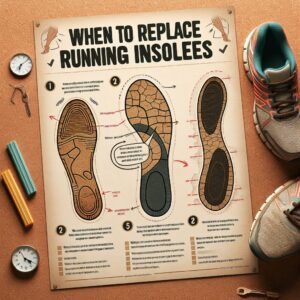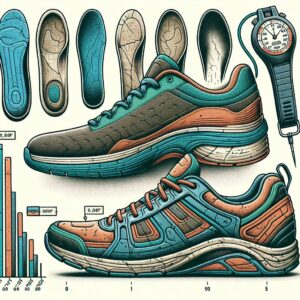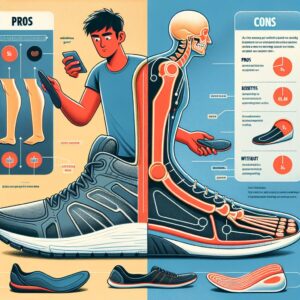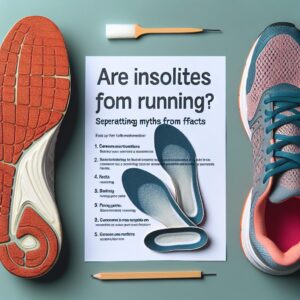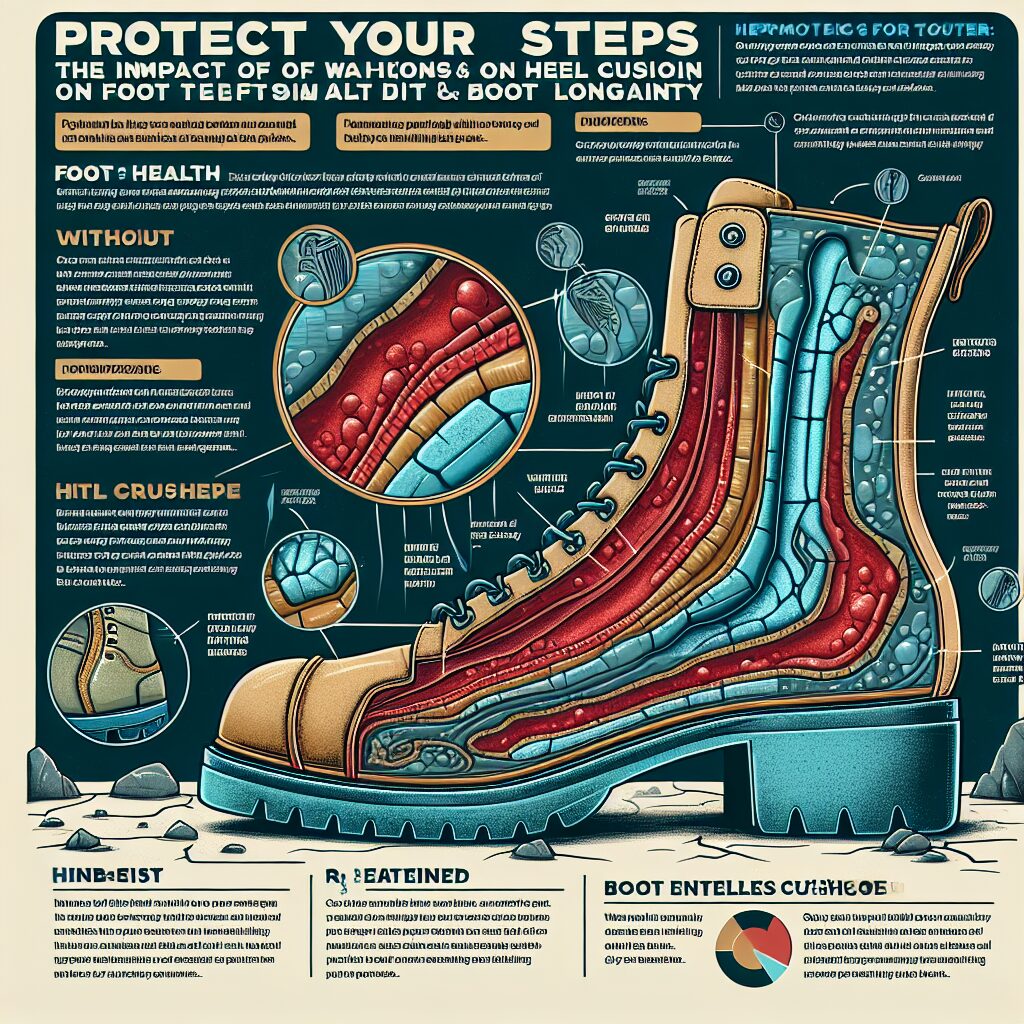
Protect Your Steps: The Impact of Heel Cushions on Foot Health and Boot Longevity
-
Table of Contents
“Protect Your Steps: The Impact of Heel Cushions on Foot Health and Boot Longevity” is an in-depth exploration of the significant role heel cushions play in maintaining foot health and extending the lifespan of boots. This study delves into the science behind foot biomechanics, the potential damage caused by prolonged use of uncomfortable footwear, and how heel cushions can mitigate these issues. It further investigates the economic benefits of using heel cushions, particularly in terms of enhancing boot longevity. The information presented is based on extensive research and evidence, making it a valuable resource for anyone interested in foot health and footwear maintenance.
Understanding Winter Insoles
As winter approaches, the need for warm, comfortable footwear becomes increasingly important. However, the quest for comfort should not overshadow the necessity for proper foot health and boot longevity. One of the most effective ways to achieve this balance is through the use of heel cushions, also known as winter insoles. These simple yet effective additions to your winter boots can have a profound impact on your overall foot health and the lifespan of your boots.
Heel cushions are specially designed insoles that provide additional support and cushioning to the heel area. They are typically made from materials such as gel or foam, which are known for their shock-absorbing properties. The primary function of these insoles is to reduce the impact on your feet when walking or running, particularly on hard surfaces. This is especially important during the winter months when icy or snowy conditions can make the ground even harder and more unforgiving.
The benefits of heel cushions extend beyond mere comfort. They play a crucial role in promoting foot health. By reducing the impact on your feet, they help to prevent a range of foot-related problems such as plantar fasciitis, heel spurs, and Achilles tendonitis. These conditions are often caused by excessive strain on the foot, which can be significantly reduced by using heel cushions. Moreover, they can also help to alleviate pain and discomfort in individuals who already suffer from these conditions.
In addition to promoting foot health, heel cushions can also contribute to boot longevity. Winter boots are often subjected to harsh conditions, including extreme cold, wetness, and rough terrain. These factors can cause the boots to wear out quickly. However, by absorbing some of the shock that would otherwise be absorbed by the boots, heel cushions can help to extend their lifespan. This not only saves you money in the long run but also reduces the environmental impact of frequently replacing worn-out boots.
Despite their benefits, it’s important to remember that not all heel cushions are created equal. When choosing a pair, consider factors such as the material, size, and shape. The material should be durable and capable of absorbing shock. The size and shape should fit comfortably in your boots and align properly with your feet. It’s also worth considering any specific foot conditions you may have. For instance, individuals with flat feet may benefit from heel cushions with added arch support.
In conclusion, heel cushions are a valuable addition to your winter footwear. They provide comfort, promote foot health, and extend boot longevity. However, to reap these benefits, it’s important to choose the right pair. With the right heel cushions, you can protect your steps and enjoy the winter season in comfort and style.
Remember, your feet are the foundation of your body. They bear your weight, keep you balanced, and carry you through your daily activities. By investing in their health and comfort, you’re investing in your overall well-being. So, as the winter season approaches, consider adding heel cushions to your winter boots. Your feet, and your boots, will thank you.
Who Needs Winter Insoles for Boots?
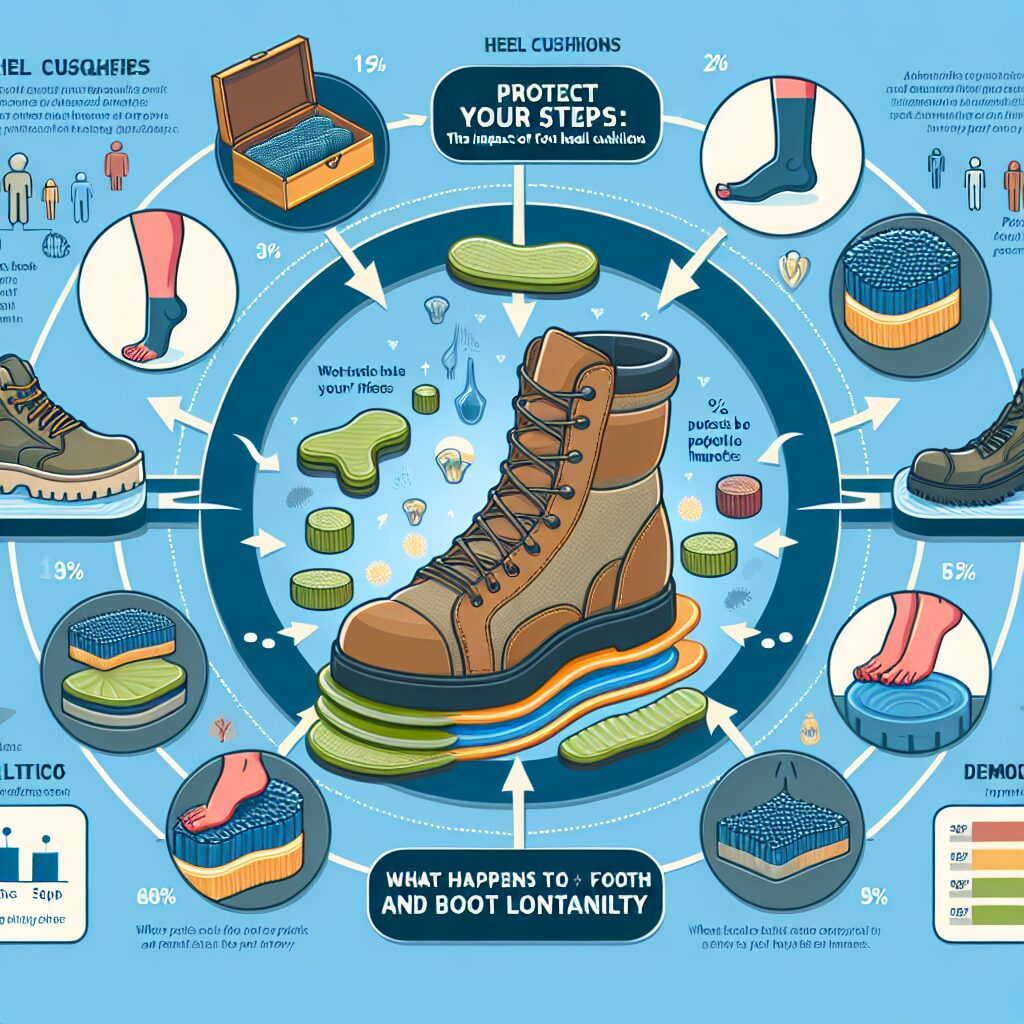
As winter approaches, many individuals find themselves reaching for their trusty boots to combat the cold. However, what many may not consider is the impact that these boots can have on their foot health and the longevity of their footwear. This is where the importance of heel cushions, or winter insoles for boots, comes into play.
Winter insoles for boots are not just for those who suffer from foot conditions or discomfort. They are for anyone who values their foot health and wishes to extend the lifespan of their boots. The use of heel cushions can significantly impact foot health and boot longevity, making them a worthwhile investment for all boot wearers.
Foot health is a critical aspect of overall well-being that is often overlooked. The feet bear the weight of the entire body, and as such, they are subject to a great deal of stress, particularly when walking or standing for extended periods. This stress can lead to a variety of foot conditions, including plantar fasciitis, bunions, and heel spurs. Heel cushions can help alleviate this stress by providing additional support and cushioning, reducing the impact on the feet and helping to prevent these conditions.
Moreover, heel cushions can also improve the fit of boots, making them more comfortable to wear. This is particularly beneficial for those who have boots that are slightly too large, as the insoles can help fill in the extra space. This improved fit can also prevent blisters and other forms of discomfort that can arise from boots rubbing against the feet.
In addition to their benefits for foot health, heel cushions can also extend the lifespan of boots. Boots, particularly those made of leather or other high-quality materials, can be a significant investment. Over time, the constant pressure and friction from walking can wear down the soles of the boots, leading to damage and reducing their lifespan. Heel cushions can help protect the soles of the boots by absorbing some of the impact from walking, reducing wear and tear.
Furthermore, heel cushions can also help maintain the shape of the boots. Without proper support, the boots can become misshapen over time, which can affect their fit and appearance. By providing additional support, heel cushions can help maintain the shape of the boots, keeping them looking their best for longer.
In conclusion, winter insoles for boots are not just for those with foot conditions or discomfort. They are a valuable tool for anyone who values their foot health and wishes to extend the lifespan of their boots. By providing additional support and cushioning, heel cushions can help alleviate the stress on the feet, prevent foot conditions, improve the fit of boots, and extend their lifespan. So, as the winter season approaches, consider investing in a pair of heel cushions. Your feet, and your boots, will thank you.
Benefits of Using Winter Insoles
The advent of winter brings with it the need for warm, sturdy boots to protect our feet from the harsh weather conditions. However, the prolonged use of these boots can often lead to discomfort and foot health issues. This is where the importance of winter insoles, particularly heel cushions, comes into play. They not only enhance the comfort of your boots but also contribute significantly to foot health and boot longevity.
Heel cushions, also known as heel pads or inserts, are specially designed to provide additional support to the heel area. They are typically made from materials such as gel, foam, or rubber, which have excellent shock-absorbing properties. When inserted into your winter boots, these cushions can dramatically improve the comfort level, especially during long walks or periods of standing.
One of the primary benefits of using heel cushions is the reduction of impact on your feet. Every step we take generates a force that travels up through our feet, potentially causing discomfort or injury over time. Heel cushions help to absorb this force, reducing the strain on the foot, ankle, and even the knee. This can be particularly beneficial for individuals with existing foot conditions such as plantar fasciitis or heel spurs, as it can alleviate pain and promote healing.
Moreover, heel cushions can also help to correct foot alignment. Many people have a natural tendency to overpronate (roll their feet inward) or underpronate (roll their feet outward) when walking. This can lead to various foot and leg problems over time. By providing additional support to the heel, these cushions can help to promote a more neutral foot position, reducing the risk of such issues.
In addition to the health benefits, heel cushions can also extend the lifespan of your winter boots. The heel area is often the first part of a boot to show signs of wear and tear due to the high level of impact it receives. By absorbing some of this impact, heel cushions can reduce the rate of wear, keeping your boots in good condition for longer.
Furthermore, heel cushions can also improve the fit of your boots. Many people find that their boots tend to slip at the heel, which can cause blisters and other discomforts. Heel cushions can help to fill in any extra space, providing a more secure and comfortable fit.
In conclusion, the use of heel cushions in winter boots offers numerous benefits. They can enhance comfort, promote foot health, improve boot fit, and extend boot longevity. However, it’s important to remember that not all heel cushions are created equal. When choosing a pair, look for ones made from high-quality, durable materials that offer good shock absorption. Also, ensure they are the right size for your boots to get the maximum benefit. With the right heel cushions, you can protect your steps and enjoy the winter season in comfort and style.
Top Winter Insoles for Boots
As winter approaches, the need for warm, comfortable footwear becomes increasingly important. Boots are a popular choice for many, providing both warmth and protection from the harsh winter elements. However, the prolonged use of boots can often lead to discomfort and foot health issues, particularly if the boots lack proper support and cushioning. This is where the importance of heel cushions comes into play.
Heel cushions, also known as insoles, are inserts that can be placed inside your boots to provide additional support and comfort. They are designed to absorb the impact of your steps, reducing the strain on your feet and lower body. This can significantly improve foot health, preventing conditions such as plantar fasciitis, heel spurs, and other foot-related ailments.
In addition to promoting foot health, heel cushions can also extend the longevity of your boots. Boots, especially those worn during winter, are subjected to a lot of wear and tear. The constant pressure exerted on the soles can cause them to wear out quickly. By using heel cushions, the impact of each step is distributed more evenly, reducing the wear on the soles and extending the life of your boots.
There are several types of heel cushions available on the market, each with its unique features and benefits. Memory foam insoles are a popular choice due to their ability to mold to the shape of your foot, providing personalized comfort and support. They are also excellent at absorbing shock, making them ideal for those who spend a lot of time on their feet.
Gel insoles are another excellent option. They are known for their superior shock absorption and cushioning properties. Gel insoles are particularly beneficial for those with high arches or flat feet, as they provide the necessary support to these areas, reducing the risk of foot pain and injury.
For those who suffer from foot odor, charcoal insoles may be the perfect solution. Charcoal has natural odor-absorbing properties, helping to keep your boots fresh and odor-free. These insoles also provide a decent amount of cushioning, although they may not be as supportive as memory foam or gel insoles.
Lastly, for those who prioritize warmth, wool insoles are a must-have. Wool is a natural insulator, helping to keep your feet warm even in the coldest of temperatures. While wool insoles may not provide as much cushioning as other types, they are often combined with other materials, such as memory foam, to provide both warmth and comfort.
In conclusion, heel cushions are an essential accessory for anyone who wears boots during the winter. They not only improve foot health by providing additional support and cushioning but also extend the longevity of your boots by reducing wear and tear. With a variety of types available, you can easily find a pair of insoles that meet your specific needs and preferences. So, as you prepare for the winter season, don’t forget to protect your steps with a pair of quality heel cushions.
Installing and Caring for Your Winter Insoles
As winter approaches, the need for warm, comfortable footwear becomes increasingly important. However, the harsh conditions and the heavy-duty nature of winter boots can often lead to discomfort and potential foot health issues. One effective solution to this problem is the use of heel cushions or insoles. Not only do they provide additional comfort, but they also contribute significantly to foot health and boot longevity.
Installing heel cushions or insoles in your winter boots is a relatively straightforward process. First, it is crucial to select the right size and type of insole that matches your foot shape and boot size. There are various types of insoles available in the market, including those specifically designed for high arches, flat feet, or general comfort. Once you have the right insole, remove the existing insole from your boot, if possible. Then, simply place the new insole inside, ensuring it fits snugly and does not move around.
However, the process does not end with installation. Proper care and maintenance of your insoles are equally important to reap their full benefits. Regular cleaning is essential to prevent the build-up of bacteria and odour. Most insoles can be hand-washed with mild soap and warm water, then air-dried. Avoid exposing them to direct heat as it can cause the insoles to warp or shrink.
In addition to cleanliness, regular inspection of your insoles for signs of wear and tear is also necessary. Over time, even the best quality insoles will wear down and lose their effectiveness. If you notice that your insoles are no longer providing the same level of comfort or support, it may be time to replace them.
The use of heel cushions or insoles can have a profound impact on foot health. They provide additional cushioning, reducing the impact on your feet when walking or standing. This can help prevent common foot problems such as plantar fasciitis, bunions, and corns. Moreover, they can correct foot alignment, reducing strain on your ankles, knees, and hips.
Insoles also contribute to boot longevity. By absorbing some of the impact, they reduce the wear and tear on the soles of your boots. Furthermore, they help maintain the shape of your boots, preventing them from stretching or deforming. This can be particularly beneficial for winter boots, which are often subjected to harsh conditions and heavy use.
In conclusion, the installation and proper care of heel cushions or insoles in your winter boots can significantly enhance your comfort and foot health, while also extending the life of your boots. However, it is important to remember that while insoles can alleviate some foot problems, they are not a cure-all solution. If you experience persistent foot pain or discomfort, it is advisable to seek professional medical advice.
As the winter season approaches, consider investing in a pair of quality insoles. Your feet, and your boots, will thank you.Heel cushions significantly contribute to foot health and boot longevity. They reduce the impact on the foot during walking or running, preventing foot conditions such as plantar fasciitis and heel spurs. Additionally, they minimize wear and tear on boots, extending their lifespan. Therefore, using heel cushions is a beneficial practice for both foot health and footwear durability.

